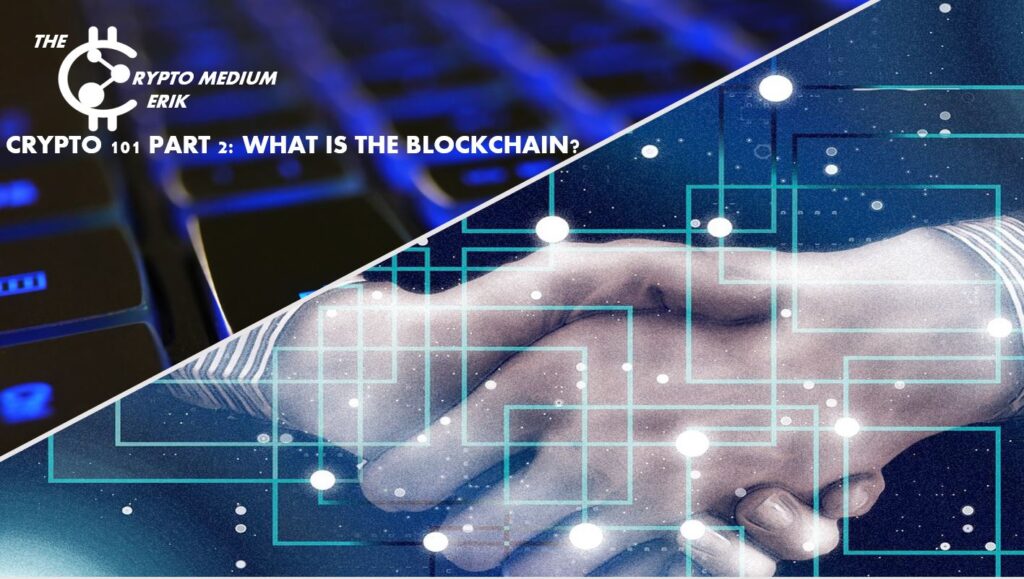
- Hi everyone, and welcome back!
- So, what is the BlockChain?
- Scenario:
- It’s day 2 of your blockchain security trial and things are not going well.
- A more descriptive look in the question; "What is the blockchain?"
- How is it different than a regular database?
- How Does a Blockchain Work?
- Bankless
- Final thoughts
- UP NEXT
- REFERENCES
Hi everyone, and welcome back!
- Hi everyone, and welcome back!
- So, what is the BlockChain?
- Scenario:
- It’s day 2 of your blockchain security trial and things are not going well.
- A more descriptive look in the question; "What is the blockchain?"
- How is it different than a regular database?
- How Does a Blockchain Work?
- Bankless
- Final thoughts
- UP NEXT
- REFERENCES
So, what is the BlockChain?
The blockchain is a distributed global database of Nodes (generally computers/modems) that allows for secure, transparent, and tamper-proof recordkeeping. It is the technology that powers Bitcoin and other cryptocurrencies. A blockchain is made up of blocks, which are chained together. Each block contains a cryptographic hash (an algorithm that maps data) of the previous block, a timestamp, and transaction data. The transaction data can be anything but is typically financial (A digital version of a classic paper ledger).

Scenario:
It’s day 2 of your blockchain security trial and things are not going well.
Your computer is chained to the desk in the corner of the room, but it’s still not enough to keep those pesky hackers from breaking in and messing with the blockchain. They seem to be one step ahead of you at every turn!
You start to wonder if this is even worth it. Maybe you should just give up and find a different way to secure the blockchain.
But then you remember why you’re doing this: to make sure that the blockchain stays safe and secure for everyone. You resolve to keep fighting, no matter what. So you head back down to the hardware store and buy a few more locks and chains.
All kidding aside, Today, I want to talk about something essential to cryptocurrency: The Blockchain.
The blockchain is a powerful tool that can be used to create a secure, transparent, and tamper-proof record of any kind of information. It has the potential to revolutionize many industries, from finance to healthcare. But like any new technology, it has its fair share of challenges. Keeping the blockchain secure is one of the most important tasks facing the crypto community today.
A more descriptive look in the question; "What is the blockchain?"
The blockchain is a distributed database that contains a record of all cryptocurrency transactions. It is constantly growing as “completed” blocks are added to it with a new set of recordings.
Each block contains a cryptographic hash of the previous block, a timestamp, and transaction data. Bitcoin nodes use the blockchain to differentiate legitimate Bitcoin transactions from attempts to re-spend coins that have already been spent elsewhere.
The blockchain is maintained by a decentralized network of computers around the world that are constantly verifying and adding new transactions to the chain.
The computers that verify the transactions are called miners, and they are rewarded with cryptocurrency for their work.
The blockchain is an essential part of cryptocurrency because it’s what allows digital currency to be secure and trustless. Without the blockchain, there would be no way to ensure that transactions are truly unique and not be duplicated or tampered with.
The blockchain is also transparent, meaning that anyone can view the entire history of a particular cryptocurrency. This transparency is one of the key benefits of cryptocurrency, as it allows for a high degree of accountability and trustlessness.
No single entity can control or manipulate the blockchain, and it is nearly impossible to tamper with transactions without being detected.
The blockchain is an essential part of cryptocurrency, and it is what makes digital currency so secure and trustless.
If you want to learn more about cryptocurrency, be sure to check out my other blog posts in this series.

appinventiv
How is it different than a regular database?

intellipaat
Simply put, databases are centralized and the Blockchain is not.
The blockchain is like a giant Google spreadsheet that is constantly updated and shared with everyone on the network.
Rather than having a centralized authority controlling and verifying all the data, the blockchain relies on a consensus algorithm to ensure that all participants in the network are in agreement about the validity of new blocks and transactions.
This makes the blockchain more secure and trustworthy because it’s much harder to game the system or tamper with the data.
A database and a blockchain may sound similar, but they are two very different things.
A database usually structures its data into tables, whereas a blockchain, as its name implies, structures its data into chunks (blocks) that are strung together.
This data structure inherently makes an irreversible timeline of data when implemented in a decentralized nature.
When a block is filled, it is set in stone and becomes a part of this timeline. Each block in the chain is given an exact timestamp when it is added to the chain. Key differences like this show that a blockchain is not just a new way to store data – it is a new way to think about data altogether.
Another difference between a blockchain and a regular database is that a blockchain is immutable. This means that once data has been added to a block, it can never be changed or removed.
This creates an unbroken timeline of data that cannot be tampered with.
A regular database, on the other hand, can be edited and changed at any time.

merehead
How Does a Blockchain Work?

euromoney
A blockchain works by keeping a record of all the transactions that take place on a network in chronological order. When a new transaction is made, it is added to the end of the chain as a new block.
Each block contains a cryptographic hash of the previous block, a timestamp, and transaction data. Bitcoin nodes use the blockchain to differentiate legitimate Bitcoin transactions from attempts to re-spend coins that have already been spent elsewhere. T
he blockchain is maintained by a decentralized network of computers around the world that are constantly verifying and adding new transactions to the chain. The computers that verify the transactions are called miners, and they are rewarded with cryptocurrency for their work.
The blockchain is an essential part of cryptocurrency because it’s what allows digital currency to be secure and trustless.
Without the blockchain, there would be no way to ensure that transactions are truly unique and not be duplicated or tampered with. The blockchain is also transparent, meaning that anyone can view the entire history of a particular cryptocurrency.
This transparency is one of the key benefits of cryptocurrency, as it allows for a high degree of accountability and trustlessness. No single entity can control or manipulate the blockchain, and it is nearly impossible to tamper with transactions without being detected.
Transparency
The transparency of transactions is DYNAMIC because every transaction can be viewed by either having a personal node or using blockchain explorers. This means that if you wanted to, your curiosity would lead you in knowing where Bitcoin goes at all times!
Decentralization
The dark side of the moon is not very bright. In fact, it might as well be a distant star because there’s nothing to reflect its light back towards Earth and thus make any difference in our everyday lives here on planet marbleous. Our solar system also has one point of failure: The sun!
If something were ever able to delete or modify all data within these servers then we would never know what happened with anything important – including your bank account information if someone hacks into them while you’re away at work (or worse).
The company’s server farm is this single point of failure. If there are any issues with electricity, internet connection or even if it burns down then all data stored on 10K computers will be lost forever!
Security
The blockchain is an unbreakable record of transactions that cannot be altered without widespread consensus from the network.
New blocks are always stored linearly and chronologically, making it incredibly difficult to go back in time more than one block away from your current location on the chain (unless a majority agrees).
Every transaction stores its own digital fingerprints alongside those previous ones- creating what’s called “hashes” which result when certain mathematical functions turn data into strings ranging between 0 – 9 or A-“Z”.
These calculations create unique digests for each entry thus ensuring there can never again exists any double spending occur because someone else would just create their own version of the blockchain with a different set of hashes.
This is what’s known as a “51% attack” and it would require an immense amount of computing power to even come close to being able to do this.
The only time something like this has ever happened was with Ethereum Classic (ETC) which resulted in a hard fork and the creation of Ethereum (ETH).
Bankless
Who needs banks when you have Bitcoin? With the decentralized nature of this new currency, all transactions can be transparently viewed by either having a personal node or using blockchain explorers that allow anyone to see what’s happening live.
People without bank accounts or any means to store their money are at a disadvantage when it comes time for them to start buying things with cash.
The World Bank estimates 1-7 BILLION people are “unbanked” or without bank accounts meaning that these people in developing countries don’t have access to bank accounts. This means they’re dependent on physical tender and leaves them vulnerable.
This is where Bitcoin comes in to try and change the world!
Not only can you send and receive payments without any fees but you can also do it without having a bank account.
All you need is a digital wallet to store your cryptocurrencies in which makes Bitcoin incredibly accessible to anyone with a smartphone and an internet connection.
Final thoughts
The future is now, and it’s a good thing too because we are living in the blockchain era.
The technology has been around for quite some time but only recently have its applications come to fruition thanks largely due bitcoin or cryptocurrency-based businesses that enabled this new economic system based on trust rather than relying solely upon central authorities like banks which often times charge hefty fees when they actually do anything useful such as giving loans out at interest rates higher than inflation could ever hope produce.
With many practical uses already implemented both bigging up business efficiency by eliminating middlemen altogether while also making sure transactions cannot be cheated through hacking attempts; you’ll soon see why entrepreneurs flocked from all corners in their army to support this ground-breaking technology!
So what’s next for the blockchain? Only time will tell, but one thing is for sure: It’s here to stay. Thanks for reading and I hope you have a better understanding of what it is! If not, that’s okay too- maybe just go ask your friendly local cryptocurrency enthusiast
Thanks for reading!
I hope this article helped you understand a little more about blockchain technology and its potential applications. If you have any questions, feel free to ask in the comments below!



Pingback: crypto 101 part 3: What Is Bitcoin? - The Crypto Medium